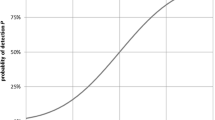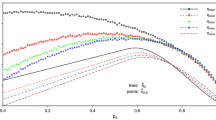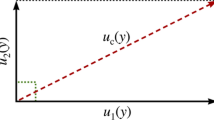Abstract
The best estimate and its standard deviation are calculated for the case when the a priori probability that the analyte is absent from the test sample is not zero. In the calculation, a generalization of the Bayesian prior that is used in the ISO 11929 standard is applied. The posterior probability density distribution of the true values, given the observed value and its uncertainty, is a linear combination of the Dirac delta function and the normalized, truncated, normal probability density distribution defined by the observed value and its uncertainty. The coefficients of this linear combination depend on the observed value and its uncertainty, as well as on the a priori probability. It is shown that for a priori probabilities larger than zero the lower level of the uncertainty interval of the best estimate reaches the unfeasible range (i.e., negative activities). However, for a priori probabilities in excess of 0.26 it reaches the unfeasible range even for positive observed values. The upper limit of the confidence interval covering a predefined fraction of the posterior is derived.





Similar content being viewed by others
References
ISO 11929 (2010) Determination of characteristic limits (decision threshold, detection limit and limits of the confidence interval) for measurements of ionizing radiation—fundamentals and application, International Organization for Standardization
Weise K et al (2013) Characteristic values in measurements of ionizing radiation—material for a critical discussion on fundamentals and alternatives, Fachferband für Strahlenschutz e.V
Wilrich P-Th (2014) Note on the correction of negative measured values if the measurand is nonnegative. Accred Qual Assur 19:81–85
Allenby GM, Rossi PE, McCulloch RE (2005) Hierarchical Bayes models: a practitioners guide. http://faculty.washington.edu/bajari/iosp07/rossi1.pdf. Accessed 12 Jan 2016
Hopke PK (1989) Target transformation factor analysis. Chemom Intell Lab Syst 6:7–19
Cox MG, Harris PM (2006) Software support for metrology best-practice guide No. 6, uncertainty evaluation, NPL report DEM-ES-011
Rivals I et al (2012) A Bayesian method with empirically fitted priors for the evaluation of environmental radioactivity: application to low-level radioxenon measurements. J Radioanal Nucl Chem 292:141–153
Korun M, Zorko B (2013) Reporting measurement results of activities near the natural limit: note and extension of the article ‘‘Interpretation of measurement results near the detection limit in gamma-ray spectrometry using Bayesian statistic’’. Accred Qual Assur 18:175–179
Author information
Authors and Affiliations
Corresponding author
Appendix: Derivation of the posterior
Appendix: Derivation of the posterior
The prior, given in Eq. (1), yields with the likelihood function defined with the measurement result x ± σ x , the posterior
where φ((a − x)/σ x ) denotes the normal distribution described by the measurement result
It should be observed that the arguments in the prior were rescaled by σ −1 x because the Dirac delta function and the Heaviside function are functions of a dimensionless parameter. Whereas the rescaling has no effect on the Heaviside function since H(a) = H(a/σ x ), the Dirac delta function is normalized to unity, i.e., ∫δ(x)dx = 1, from where it follows ∫δ(a/σ x )da = σ x .
The constant C follows from the normalization condition for the posterior
Since f(x,a) δ(a) = f(x,0) δ(a) for the normalization constant follows
where Φ(x/σ x ) denotes the cumulative function of the standardized normal distribution. Then it is easy to see that the posterior is also a linear combination of the Dirac delta function and a normal distribution truncated at zero. The coefficients of this linear combination are
and
for the Dirac delta function and the truncated normal distribution, respectively.
Rights and permissions
About this article
Cite this article
Korun, M., Vodenik, B. & Zorko, B. Calculation of the best estimates for measurements of radioactive substances when the presence of the analyte is not assured. Accred Qual Assur 21, 191–195 (2016). https://doi.org/10.1007/s00769-016-1198-8
Received:
Accepted:
Published:
Issue Date:
DOI: https://doi.org/10.1007/s00769-016-1198-8




